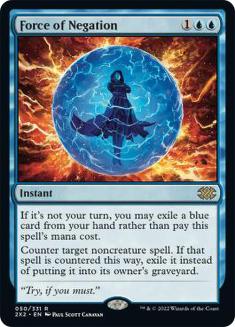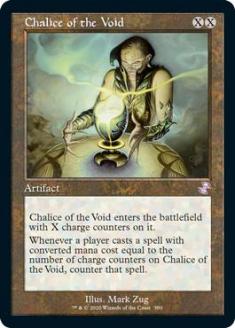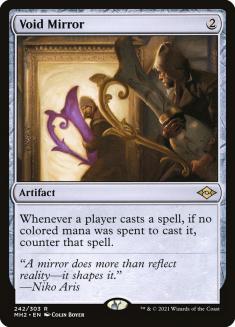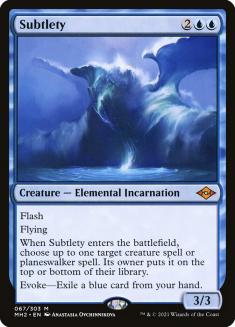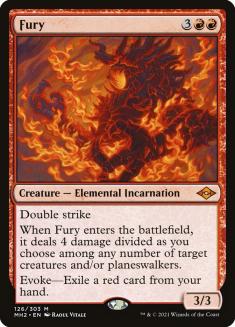Undoubtedly, last weekend belonged to Shardless Agent. Cascade decks took both finals spots in the 2021 Hunter Burton Memorial Open and the Modern Super Qualifier on Magic Online (MTGO). Past that, they littered the Top 8s of the regular Challenges.
Now, these are clearly powerful decks, so the fact that they’ve re-emerged as top contenders isn’t surprising. But what is surprising is that both major cascade archetypes, Living End and Crashcade (the latter of which comes in Temur and Four-Color sub-archetypes), are still around in significant numbers.
Creatures (17)
Lands (23)
Spells (20)
Sideboard

Creatures (14)
Planeswalkers (2)
Lands (23)
Spells (21)
Sideboard

Normally by now you’d see the metagame condense around whichever archetype performed best. The other would fall away as a worse version of a similar strategy. But Living End and Crashcade are different enough that they’ve both survived since the opening week of Modern Horizons 2.
That said, I do think Crashcade is the better of the two by a significant margin. There are three compelling reasons why.
1. Crashcade Interacts Earlier and More Often
One of the theoretical deckbuilding constraints of the cascade decks is a lack of cheap spells, which presumably you make up for with a more powerful play on Turn 3. But in a format as vast as Modern, there are plenty of ways to get around this restriction, from the Force cycle in Modern Horizons to the Elemental Incarnations in Modern Horizons 2 to various split cards whose total mana value is the sum of each individual piece.
Each of these decks plays several such cards, but because Crashcade doesn’t need to play a pile of cycling creatures to make its cascade engine work, it has space for more of these interactive pieces. Living End typically plays Force of Negation, Grief, and a couple of Brazen Borrowers in the maindeck, while Crashcade has Prismari Command, Dead // Gone, Fire // Ice, Brazen Borrower, and Bonecrusher Giant.
This suite of interaction makes it much better at stopping early Ragavan, Nimble Pilferers; Dragon’s Rage Channelers; and other early threats. Living End certainly has the more powerful cascades later in the game as a trade-off, but that doesn’t matter when your opponent has had time to set up a counter wall to protect their position or has enough burn left in their hand to finish the game even after losing their battlefield.
Past that, plenty of decks in Modern can end the game on Turn 3 if left undisrupted, notably Mono-White Hammer (Lurrus), where the plethora of cheap removal spells employed by Crashcade are all quite effective. Most notably among this list is Fury, a recent addition to Crashcade decks that excels in the current metagame with so many cheap creatures and an emphasis on taking over the battlefield. Living End may touch red for Violent Outburst, but it doesn’t have the ability to play enough red cards to make Fury a viable option.
Living End instead focuses its disruption, usually a combination of Force of Negation, Grief, and Brazen Borrower, on helping to force through its combo. Grief and Force of Negation can interact with opposing counters and discard, and Brazen Borrower ensures you have an answer to a maindeck Chalice of the Void or one found with Karn, the Great Creator.
There’s little concern with staying alive against your opponents’ early aggression, and with how efficient Modern is these days, that’s a problem. I don’t want to be in a position where I’m depending on my opponents to stumble these days, because it just doesn’t happen very often. I’d rather be able to make them stumble by having good interaction, even if it comes with a less powerful payoff turn later on.
2. Crashcade Worries Less About Hate
Notably, Living End uses its namesake card as a way to make up for its lack of interaction, since it can completely reverse the landscape of the battlefield by taking you from a major deficit to an insurmountable advantage. However, that in turn creates more reliance on resolving that card, thereby exposing the deck further to opposing hate.
Cards like Chalice of the Void and Void Mirror appear throughout Modern sideboards since they’re so effective against Cascade strategies while also having applications elsewhere. With one on the battlefield, Living End has few options to affect the battlefield, and can quickly find themselves spinning their wheels, frantically cycling to try to find a Petty Theft. Crashcade decks can play a reasonable game without resolving Crashing Footfalls, buying plenty of time to find an answer.
Moreover, Crashcade decks have more answers to these cards to begin with. With only Brazen Borrower in the maindeck to take one of these artifacts off the battlefield, Force of Vigor and Foundation Breaker are staples in Living End sideboards. Crashcade decks, with access to more copies of Brazen Borrower and Prismari Command, and also Teferi, Time Raveler in the maindeck of four-color variants, doesn’t have to go nearly as far in committing sideboard space to answer these common hate cards.
Beyond those artifacts, there’s the obvious vulnerability to graveyard hate that Crashcade doesn’t have to worry about but Living End certainly does. Endurance has joined the fray as another powerful piece of hate that sees maindeck play in some decks, and the traditional graveyard hate cards, Nihil Spellbomb, Soul-Guide Lantern, Rest in Peace, etc. aren’t going anywhere.
Living End can take solace in the fact that Sanctifier en-Vec has pushed out some number of Rest in Peaces and is far less effective, but it’s still a vulnerability to that Crashcade lacks. In a narrower metagame, this wouldn’t be as much of an issue, since there’s only so much space players will devote to each deck, but Modern has been expanding in recent weeks, as Mono-Green Tron, Burn, and other older decks have found space to succeed in beating the decks that go over the top of Ragavan and friends.
As a result, sideboards are being spread quite thin these days, and it’ll be difficult to include too many copies of Void Mirror and Chalice of the Void. But those in combination with some graveyard hate is an excellent sideboard approach against such a linear deck as Living End. And if graveyard hate declines, it’ll likely mean an increase in space available for Chalices and Void Mirrors, so not much of a gain for Living End.
Essentially, with so many ways to attack it, there isn’t a conceivable metagame where there isn’t much hate for Living End, but there are metagames where people will be unprepared for Crashcade. With the recent success of Cascade decks, I doubt the latter comes around this or next weekend, but I’m taking a long-term view with this analysis, and sooner or later the metagame will cycle into a more favorable position for Rhinos.
3. Crashcade Is More Flexible
Note that when I talk about flexibility, I’m referring to the build itself. That Crashcade is more flexible in how its build is obvious when you look at lists and there’s much more variability in those than in different builds of Living End. There’s even two different variants, one splashing white for Teferi, Time Raveler and potentially Ardent Plea as well as more sideboard options. But exactly why this is important is more subtle, and it comes up in two places.
The first is in sideboarding. With a deck like Living End, every card you cut from the core engine makes all the other pieces of that engine worse. And since so much of the maindeck is devoted to parts of that engine, sideboarding becomes rather tricky. You either have to keep sideboarding out the same few cards, or make your core gameplan worse. Neither option is particularly exciting.
With Crashcade, the cascade engine is much leaner, and thus you have more options in how to sideboard, most importantly the option to bring in a lot of cards without hurting your engine too much.
Also, with only twelve cards devoted to casting Crashing Footfalls, you can significantly cut down on that aspect of the deck should your opponent be overloaded on ways to stop it. You could easily cut the Violent Outbursts and trim a Crashing Footfalls or two and play as a glorified Temur Midrange deck. This isn’t an exciting prospect either, but if your opponent has a pile of hate cards, then their deck will also be neutered, so you’re fighting on at least even terrain there. And the fact that you can make such a drastic decision will often prevent opponents from even attempting to overload on hate in a way they would never do against Living End.
The second way in which deckbuilding flexibility is important is in metagaming. Crashcade decks switched from Subtlety to Fury and could similarly play maindeck copies of Endurance in graveyard-heavy metagames, or Mystical Disputes to beat control and combo. As I noted earlier, Living End plays ten cards that aren’t part of its core engine, and those disruption pieces are specifically designed to support the combo by stopping the opponent’s answers. It has nearly zero ability to adapt its maindeck to different metagame changes.
This means that Living End will always depend on other decks ignoring it to some degree in order to have success, whereas Crashcade decks can succeed even in prepared metagames by finding the right configuration to counteract the hate. The latter is difficult to do, but important if you plan to stick with one deck for the long term, which has benefits in building your familiarity with different card choices, matchup dynamics, and sideboard plans.
The Costs of Linearity
There is a common thread in all of these advantages that Crashcade decks have over Living End, and it’s the fact that the former is a non-linear deck while the latter is linear. Linear decks are defined by their commitment to a single, powerful plan that they hope will overpower their opponents. But with that power comes several costs, and among those is less interaction for your opponent’s strategy, an increased vulnerability to opposing disruption, and a lack of deckbuilding flexibility.
This is not to say that linear decks cannot succeed. They have succeeded and will continue to do so in the future, but in order for them to do so one of two things has to be true. Either the metagame has to be unprepared to answer their strategy, or they have to be fast enough, consistent enough, and resilient enough to defeat a prepared metagame. The last Modern deck to accomplish the latter was Hogaak, and indeed any linear deck that does so for very long will meet its fate at the ban hammer.
And linear decks that fail to break the format will eventually find themselves facing a prepared metagame, and once they do, they must recede into the fringes of the metagame until the hate declines and they can once again take advantage of an unprepared field. This is the fate of all linear decks, especially in Modern because of the myriad cheap, powerful disruptive cards that decks can employ to stop you.
Moreover, once the metagame figures out how to combat a linear deck, it becomes like a vaccinated immune system. It already knows what the right antibodies are to fight the infection, and is prepared to produce them more quickly each time the infection recurs. Likewise, a knowledgeable metagame knows how to adapt their decks to beat you, and will do so immediately upon seeing Living End, Dredge, or any other linear deck pop up again. So you have a smaller and smaller window to take advantage of an unprepared metagame each time you go back to it.
So while there may be isolated weekends where Living End is the better choice than any Crashcade variant, over a period of months and years with new cards and changing metagames, Crashcade will perform better. You just have to keep up with the metagame and make the necessary adjustments to your build and sideboard plans.
If you’re looking to join the Shardless Agent squad in Modern, go for the Rhinos.


